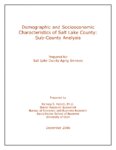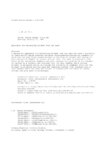TO
Filters: Collection: "ir_eua" Type: "Text"
| Title | Date | Subject | Description | ||
|---|---|---|---|---|---|
| 1 |
 |
Method and appratus for extracting tar sand | 1983-11-22 | tar sand extraction; extraction method; patent; tar sand; extraction apparatus | Method and apparatus for separating coarse sand particles from fine sand particles in a slurry of sand and a solution such as results from the solvent extraction of tar sand, such method comprising causing flow of such slurry in a generally horizontal direction and then causing upward flow at a rate... |
| 2 |
 |
Demographic and socioeconomic characteristics of Salt Lake County: sub-county analysis | 2006-12 | Salt Lake County; Projections; Estimates; Aging population; Baby boom; Utah; Salt Lake Aging Services; Kennecott Land | This paper is an examination of the shifting geographic distribution of the population within Salt Lake County over time as well as an analysis of the spatial distribution of its demographic and socioeconomic characteristics. It builds on the county-level analysis included in a separate section of t... |
| 3 |
 |
Transportation system map portfolio | 1969-12 | ||
| 4 |
 |
Salt Lake County's distinctive demographics: implications for the aging population | 2006-12 | Salt Lake County; Projections; Estimates; Aging population; Baby boom; Utah; Salt Lake Aging Services; Kennecott Land | Salt Lake County is the economic, political, and cultural center of Utah. The county is currently home to nearly 40 percent of Utah residents and generates about half of all jobs in the state. It remains the most populous county, with a million of the state's 2.6 million residents,1 and its daytime ... |
| 5 |
 |
Basic Institutional Data for the University of Utah | 2006-08-30 | Accreditation; Higher Education, University of Utah | Northwest Commission on Colleges and Universities Basic Institutional Data Form for the University of Utah |
| 6 |
 |
Chemistry and resources of heavy oil and natural bitumen deposits | 1989 | chemistry of heavy oil; chemistry of natural bitumen deposits; heavy oil resources; natural bitumen deposits; heavy oil; unconventional oil deposits; natural bitumen | Supplies of conventional crude oil are diminishing; therefore, it is important to understand the reservoir characteristics of unconventional oil deposits. Reservoirs of unconventional deposits contain oils heavier than 20° gravity API and natural bitumens (tar sands and oil sands) are more viscous ... |
| 7 |
 |
Evaluation Committee, October 9-11, 2006 | 2006-09-26 | Accreditation; Higher Education, University of Utah | Northwest Commission of Colleges and Universities Evaluation Committee |
| 8 |
 |
Metallopetroporphyrines as process indicators: Separation of petroporpyrins in Green River oil shale pyrolysis products | 1994-11 | product oils; LLNL hot-recycled-solids; HRS retorting process; metallopetroporphyrins; process indicators; petroporpyrins; Green River oil shale pyrolysis | Product oils from the LLNL Hot-Recycled-Solids (HRS) retorting process were separated to isolate and concentrate the metallopetroporphyrins. A modified column chromatography procedure developed previously for heavy crude oils and tar sand bitumens was used. The fractions were then examined by UV-vis... |
| 9 |
 |
Technical aspects of oil shale production and processing | 2008-11-13 | oil; oil sand; oil shale; energy production; resource characterization pyrolysis; ex-situ process. | |
| 10 |
 |
Comparison of kinetic analysis of source rocks and kerogen concentrates | 1994-05-10 | Shales and kerogen concentrates from the Green River, Rundel, Ohio, Kimmeridge, and Phosphoria formations were examined by Pyromat II micropyrolysis and kinetic parameters were determined by the shift-in-Tm a x , discrete distribution, modified Friedman, and modified Coats-Redfern methods. Overall, ... | |
| 11 |
 |
Metallopetroporphyrins as process indicators: mass spectral identification of Ni (ETIO) and Ni (DPEP) homologous series in Green River shale oil | 1994-12-05 | mass spectral identification; Green River shale oil; shale oil | Mass spectrometry (MS) of the porphyrin fraction of a demetallated shale oil from the LLNL Hot-Recycled-Solids retorting process exhibited homologous series of C25 to C33 (C28 maximum) for etio and C26 to C36 (C30 maximum) for DPEP (isocyclic) porphyrins, respectively. The sum of intensities after b... |
| 12 |
 |
Fall 2020 Instructional Guidelines | 2020-07 | COVID-19; instruction; campus | Fall 2020 Instructional Guidelines |
| 13 |
 |
Salt Lake area transportation study: volume I current travel inventory | 1963-11 | A major element of this study was the review of current travel patterns generated by the 394,000 residents of the Salt Lake area as determined from a 1960 comprehensive origin-destination survey which was conducted by the Department of Highways. Supplemental studies covered commercial vehicle m... | |
| 14 |
 |
Chemistry and mineralogy of natural bitumens and heavy oils and their reservoir rocks from the United States, Canada, Trinidad and Tobago, and Venezuela | 1989-12-21 | Twenty-one samples from natural bitumen and heavy oil deposits in seven States of the United States and six samples from outside the United States form the basis of this initial study. This Circular gives the mineral content of the reservoir rock, the trace-element distribution in the reservoir rock... | |
| 15 |
 |
Population characteristics of the Salt Lake Metropolitan Area | 1964-01 | This study could not have been undertaken without the assistance of many. An expression of gratitude is due Dr. Osmond L. Harline, Director of the Bureau of Economic and Business Research, and Dr. Clyde N. Randall, Dean of the College of Business, of the University of Utah, who responded to the orig... | |
| 16 |
 |
Apparatus for extracting bitumen from tar sand | 1982-01-19 | Patent; Extracting bitumen from tar sand; Extraction chambers; Countercurrent flow; Plurality; Individually sealed pressure adjusted interconnected extraction chambers in series; Tar sand; Bitumen | A method and apparatus for extracting bitumen from tar sand utilizes a plurality of individually sealed pressure adjusted interconnected extraction chambers in which the tar sand flows countercurrent to the flow of solvent with mixing in each extraction chamber of solvent and tar sand. Tar sand is p... |
| 17 |
 |
Hypotheses of oil-shale genesis, Green River Formation, northeast Utah, northwest Colorado, and southwest Wyoming | 1985 | oil shale; Green River Formation; tar sandstone | In the six decades or so of oil-shale studies on the Green River Formation (Paleocene/Eocene) in northeast Utah, northwest Colorado, and southwest Wyoming, two alternative hypotheses for the paleoenvironment have dominated the literature: (1) a stratified lake in which anaerobic conditions in the hy... |
| 18 |
 |
UUSAC parking request 1993-1994 | 1994 | Committees | Notes, letters and memos of the University of Utah Parking, Transportation, Traffic Modeling Project Settering Committee. |
| 19 |
 |
An echoing in-situ combustion oil recovery project in a Utah tar sand | 1982 | in-situ combustion; oil recovery project; Utah tar sand; echoing in-situ; U.S. tar sand resources; reverse combustion process; heterogeneous tar sand reservoir | U.S. tar sand resources contain an estimated 30 billion bbl (4.7 Gm3) of oil in place in about 550 occurrences in 22 states. Over 90% of the known resources are in six large deposits in Utah, each containing from 1 to 16 billion bbl (0.15 to 2.5 Gm3) of oil. 1 Four major tar sand deposits in Alberta... |
| 20 |
 |
Method for filtering solvent and tar sand mixtures | 1985-09-03 | filtering solvent; filtering tar sand mixtures; tar sand; paten | A method for filtering spent tar sands from a bitumen and organic solvent solution comprises separating the solution into two streams wherein the bulk of the coarser spent tar sand is in a first stream and has an average particle size of about 10 to about 100 mesh and the bulk of the finer spent tar... |
| 21 |
 |
Depositional setting and preliminary oil-shale resource potential, southwestern Uinta Basin, Utah | 1982 | Oil shale; Uinta Basin; Utah; Green River; Oil yield; Lake Uinta; Mohogany zone; Kerogen; Sheep Pass; Elko Basins; Nevada; Strawberry Structure; Strawberry Reservoir | This report characterizes the potential oil-shale resources underlying those lands west of the Green River in the southwestern Uinta Basin, Utah. The principal evaluation technique has been the calculation of oil yield from oil-well sonic and density log data available in this area. Subsurface corre... |
| 22 |
 |
Barriers to industrial development in Utah's portion of the four corners region | 1970-06-01 | Utah's portion of the Four Corners area is composed of the 21 counties which are south and/or east of Salt Lake County. The Utah Four Corners area covers 65,000 square miles which is approximately 80 percent of the state. The are a has a population of 274,500 dispersed throughout the region in a ver... | |
| 23 |
 |
Economic & demographic futures 1980-2000 | 1980-01 | Special acknowledgement is appropriate for the efforts of the Community Planning Policy Committee which provided continual guidance to the Water Quality staff over a six month period; in addition to Jean Watanbe, Office of the State Planning Coordinator, Brad Barber and Greg Selby formerly with the ... | |
| 24 |
 |
Population projections for Utah's cities & unincorporated Areas 2000-2030 | 2000-06 | Utah's seven associations of government1 have produced these city and unincorporated area population projections for each year from 2000 through 2005 and for the years 2010, 2020, and 2030. These are consistent with the county population projections produced by the Governor's Office of Planning and ... | |
| 25 |
 |
University of Utah Staff Advisory Committee (UUSAC) minutes 1997 | 1997 | University of Utah employees | Minutes for the University of Utah Staff Advisory Committee. |
